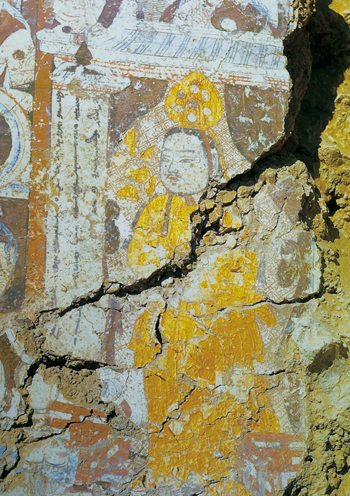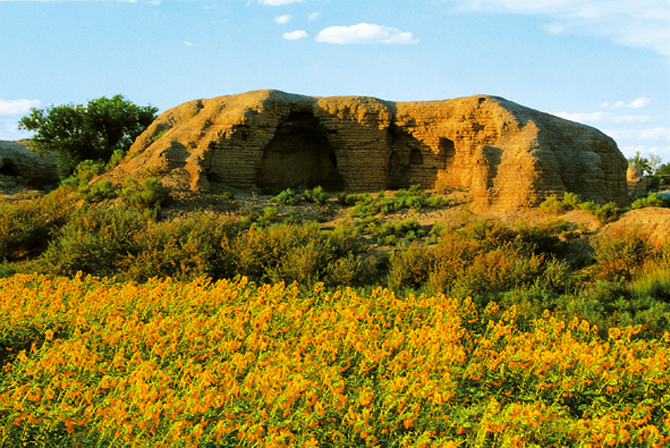Written by: Shi Xiaoqi
Posted on: January 16, 2013 |  | 中文
| 中文
The ancient Beiting Administrative Office, a special administrative body in the Western Regions, was established in the Tang Dynasty (618-907AD). The site of the ancient Beijing Administrative office is situated in the present Beiting Township, over 10 km north of Jimsar County proper, in the north of Xinjiang Uyghur Autonomous Region. This site, also called Pochengzi (the ‘Broken City’), it is one of the Cultural Relics of National Importance under the Protection of the State.
Ancient Beiting was a historically famous town in terms of its strategic significance. Over the past 2,000 years, Beiting was inhabited by many ethnic groups, such as Saka, Cheshi, Scythae, Avars, Turks, Uyghurs and Mongolians. In the year of 59 BC, the central government of the Western Han dynasty (206 BC-8 AD) established the Back Kingdom of Cheshi in Beiting. In the year of 703AD, the central government of the Tang Dynasty (618-907 AD) established the Beiting Administrative Office there, as the highest administrative and military body that ruled the whole area of the ancient Western Regions. Its office site was located in the plain area of the present Jimsar County. As the political and economic centre of ancient Xinjiang at that time, as well as a major transport hub of the new north route of the Silk Road, Beiting prospered during the Song (960-1279AD ) and Yuan (1271-1368AD) Dynasties.
As early as the Spring and Autumn Warring Period of ancient China (770 BC-221 BC), the six kingdoms of Tianshan Mountain area established by Saka people were in the Beiting area. In the early period of the Western Han Dynasty (206 BC-25 AD), Beiting was the capital of the Back Kingdom of Cheshi, also called Houting. In the second year of the Emperor Xuanwu of Western Han Dynasty, (Shenjue 60 BC), the central government of the Western Han Dynasty built Jinman City here after the establishment of the Western Regions Administrative Office.
 The ancient Beiting town was formed in the Western Turks Period of the Northern and Southern Dynasty (420-589AD). The Sogdians, famous businessmen in the history of central Asia, set up their own trade center, using camels for transportation, to connect Inland China, the Ancient Western Region (present Xinjiang), other parts of Asia and Europe. The Turks named it ‘Khan Buddha Town,’ which was the origin of Beiting.
The ancient Beiting town was formed in the Western Turks Period of the Northern and Southern Dynasty (420-589AD). The Sogdians, famous businessmen in the history of central Asia, set up their own trade center, using camels for transportation, to connect Inland China, the Ancient Western Region (present Xinjiang), other parts of Asia and Europe. The Turks named it ‘Khan Buddha Town,’ which was the origin of Beiting.
In the 12th year of the Emperor Xuanzong of the Tang Dynasty (638 AD), the ancient Western Turks (referring to the Turks tribes from Mongolian Highland that settled in the Ancient Western Regions of the time) established two Khanates. Yipiduolu Khan established his capital here and it became Belting, and Yipishapoluo Khan set his capital city here in the south in Nanting. In the fourteenth year of the Emperor Xuanzong of the Tang Dynasty (618-907 AD), the central government of the Tang established Tingzhou Administrative Office, which exercised jurisdiction over three counties including Jinman, Pulei and Luntai. Later, Jinman County was renamed Houting County.
In 702 AD, the Tang Empress Wuzetian established the Beiting Administrative Office (upgraded to the Grand Office later) to strengthen its administration over the Ancient Western Regions of China. The Beiting Office had a vast area under its jurisdiction including the northern area of the Tianshan Mountains, the Balkhash Lake area, and as far as the eastern area of the Caspian Sea with an Army (Hanhaijun) stationed there. At that time Beiting had a dense population and enjoyed economic prosperity as a major transport hub in the Silk Road and a strategic military juncture. The status of Beiting at that time equaled that of present day Urumqi. The first Chief Administrator of Beiting Administrative Office, Yanghe, appointed by the central government of the Tang Empire had a position of the Second Official Rank of the Tang Court, which was equal to the vice premier of the country today. It was a splendid period of the town. Afterwards, the walls of Beiting were repaired and enlarged. Beiting was well known over the ages.
The ancient town of Beiting was 1,500 meters from north to south, and about 1,000 meters wide from the east to the west, its perimeter totaling 4,590 meters. The town was divided into three sections by walls, outer, middle and inner. The second wall is 600 m long from north to south, and 400 m wide from east to west. The outer wall has the same side length, being 200 m. The outside wall was seven to ten meters thick, built with rammed earth. The inner wall varied in width from three meters to five meters, and is about seven meters in height. All the inner and outside walls had their gates respectively in the south, north and west. The north gate served as the main gate. The buildings of the administrative office were in the inner city, and in the second section there were streets and markets, and in the outer town there was the Hanhai Army garrison and a residential area. There were rivers flowing to the east and the west of the town, each about 200 meters wide. The two rivers met at the west side of the north gate, forming a crescent shaped lake with beautiful willows and flowers on the banks.
In the inner town of Beiting, there were buildings, gardens and trees, as well as a big temple. People of ancient Beiting were skilled at metallurgy and jade sculpture. All industries were booming. Animal husbandry developed and bred many famous horses. The horses were divided into different herds by their hair colour for breeding purposes. According to the ancient records, the people enjoyed a rich and peaceful life; even the poor had meat as their staple food. Salmiac was in the mountain (the present Karamori Mountain) of Beiting. The smoke of the salmiac looked like clouds or fog in the daytime, while at night it was so bright that people could see the wild animals in the distance. It dyed the ground a very spectacular red.

As the military and political center in the north of the Tianshan Mountain area during the Tang Dynasty times, Beiting played an important role in the history, similar to Anxi Grand Administrative Office in the area south of Tianshan Mountains. Censhen, a famous Tang poet who lived in Beiting wrote many masterpieces. His poems are still regarded as a cultural treasure of Beiting.
Beiting was called Bechbaliq during the Yuan Dynasty, which used the name of a town of the five that the kingdom of Cheshi had established in the Han Dynasty. Genghis Khan sent a Darughachi (an official title in the Mongolian army of the time) to govern Beiting and stationed a large military force there, taking it as the secondary capital. In the first year of the Emperor Xianzong of the Yuan Dynasty (1251 AD), an high level administrative office of the area was established as the highest administrative body in Bechbaliq, which was similar to the 11 provinces of Inland China. In the 23rd year (1286AD) of the Yuan Dynasty, a Marshal Office, the highest military rank in the Yuan Empire, was set in Beiting.
In 10th year (1412 AD) of Emperor Yongle of the Ming Dynasty, Beiting was destroyed in a war. In the 16th year (1418AD), the central government of the Ming Dynasty (1368-1644AD) moved the political center to Yilibal (the present Ili). Beiting began to decline, and finally the town was further deserted and finally disappeared.
Selected From Place of Historic Interest and Scenic Beauty in Xinjiang, China (CHINA INTERCONTINENTAL PRESS, BEIJING, 2011)
You may also like: